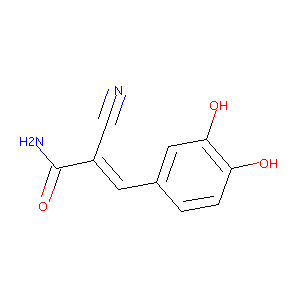Details of the Drug
General Information of Drug (ID: DMCN6PY)
| Drug Name |
2-cyano-3-(3,4-dihydroxyphenyl)acrylamide
|
||||||||||||||||||||||
|---|---|---|---|---|---|---|---|---|---|---|---|---|---|---|---|---|---|---|---|---|---|---|---|
| Synonyms |
Tyrphostin 46; Tyrphostin A46; AG 99; Tyrphostin B40; 122520-85-8; alpha-Cyano-(3,4-dihydroxy)cinnamide; AG-99; 3,4-Dihydroxy-alpha-cyanocinnamamide; UNII-ARL2OF9022; CHEMBL296407; ARL2OF9022; 118409-59-9; Tyrphostin AG 99; (E)-2-cyano-3-(3,4-dihydroxyphenyl)prop-2-enamide; NSC666250; NSC-666250; 2-Propenamide, 2-cyano-3-(3,4-dihydroxyphenyl)-; (~{E})-3-[3,4-bis(oxidanyl)phenyl]-2-cyano-prop-2-enamide; Tyrphostin AG99; 3,4-Dihydroxy-alpha-cyanocinnamide; NSC 666250; Tocris-0497; Tyrphostin deriv. 40; BiomolKI_000013; AC1NS5AR
|
||||||||||||||||||||||
| Indication |
|
||||||||||||||||||||||
| Drug Type |
Small molecular drug
|
||||||||||||||||||||||
| Structure |
 |
||||||||||||||||||||||
| 3D MOL | 2D MOL | ||||||||||||||||||||||
| #Ro5 Violations (Lipinski): 0 | Molecular Weight (mw) | 204.18 | |||||||||||||||||||||
| Logarithm of the Partition Coefficient (xlogp) | 0.4 | ||||||||||||||||||||||
| Rotatable Bond Count (rotbonds) | 2 | ||||||||||||||||||||||
| Hydrogen Bond Donor Count (hbonddonor) | 3 | ||||||||||||||||||||||
| Hydrogen Bond Acceptor Count (hbondacc) | 4 | ||||||||||||||||||||||
| Chemical Identifiers |
|
||||||||||||||||||||||
| Cross-matching ID | |||||||||||||||||||||||
Molecular Interaction Atlas of This Drug
 Drug Therapeutic Target (DTT) |
|
||||||||||||||||||||||||||
|---|---|---|---|---|---|---|---|---|---|---|---|---|---|---|---|---|---|---|---|---|---|---|---|---|---|---|---|
| Molecular Interaction Atlas (MIA) | |||||||||||||||||||||||||||
Molecular Expression Atlas of This Drug
| The Studied Disease | Discovery agent | |||||||||||||||||||||||
|---|---|---|---|---|---|---|---|---|---|---|---|---|---|---|---|---|---|---|---|---|---|---|---|---|
| ICD Disease Classification | N.A. | |||||||||||||||||||||||
|
||||||||||||||||||||||||
| Molecular Expression Atlas (MEA) | ||||||||||||||||||||||||
